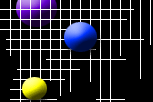This God is a Supernal Mother who
rides and rises with
a triumphant
shout. (Tiqqine
haZor, 47a)
After extensive research the scholar,
Raphael Patai, put out his final version
of his book,The Hebrew Goddess
(1978).
I find this book
extremely significant;
for the Hebrew
Bible is the core source
of God as the Super Male Patriarch not
only of Judaism, but also Islam, and
Christianity as well, complete with all
the ludicrous personifications of some
monarchical dictator in the sky. Even
if we see God's gender as a symbol, it
is an extremely unbalanced one: for we
have at least two genders in our world,
not just one.
But how valid is the Hebraic source of a
masculine God? Far beyond the golden calf,
the Hebrew Testament
is rife with the
ancient tribes slipping into
the worship of
other deities (of
which Patai gives ample
scriptural examples).
On up to the
Babylonian conquest and Jewish Exile, the
Goddess, Asherah, was the most constantly
named of the deities competing with YAHWH
among the Hebrew tribes. (Asherah dates
back as far as 1750 BCE to her origins
in
ancient Sumer.)
A three-foot storage jar was found in
northeastern Sinai dating to 800 BCE.
On it was inscribed: "May you be
blessed by Yahweh and his Asherah".
Here we have some
objective evidence
beyond Biblical censorship that in
some quarters Asherah may have been
considered Gods consort or wife!
Later, many more such
artifacts were
discovered. See
"The Lost Goddess of
Israel" in the March/April
2005
addition of the journal,Archeology,
(p.36-41) for the latest fascinating
facts on this subject.
After the Hebrews return from Exile,
around 400 BCE, their
religion became
shored up into a strict patriarchy,
with God at the head.
But even before
the first century CE the feminine
"Wisdom" was being personified in the
Book of Proverbs and other sacred books
as God's earliest creation and perpetual
playmate. The
Jewish philosopher, Philo,
regarded the goddess, Wisdom, (or Sophia)
as the wife of God.
At that time Gnostic
writings, both Jewish and Christian,
were
emphasizing the female
element in religious
thought.
By the time of the Dark Ages in Western
civilization, Jewish scholars of the Near
East were already sowing the
conceptual
seeds of the Hebrew Kabbalah. The esoteric
movement moved into Italy in the 9th
century,
and in the 11th to 13th
century epitomized in
Spain. Moses
de Leon (1240-1305) composed the
Zohar (Book of Splendor)
in which the feminine
element played a very significant role.
By the 16th century, renowned Jewish
scholars like Moses
Cordovero and Isaac
Luria brought the sacred diagram
of the
Sefirot into full fruition. Throughout
the symbols of the Sefirot, the male
and
female principles were in
perfect balance.
Soon the Shekhina,
God's female counterpart,
took precedence among both
scholars and the
Jewish people.
Shekhina is derived from the Biblical
word, "shakhan", meaning "dwelling in".
Shekhina was said to have dwelt within
the Holy of Holies during the Temple
periods as the Cherubim
embracing God.
After the Temple's final destruction,
when the Hebrews were ruptured from God,
it was the Shekhina who dwelt among
and
within her people as the female
Presence
of the Godhead.
Philo called the Shekhina Gods inner Kingdom
on this earth, which
was echoed by the
Talmud: "And Gods Shekhina
dwelt among them"
And the Midrash states: "God said, I shall act
as both Father and Mother for my people." She
was also called Makhut, the maternal
gateway
to the Divine Godhead. The Jewish people
yearned to unite God
with his Shekhina.
Some therefore equated the Shekhina with
Israel itself. But the great Jewish scholar,
Ezekiel Landu (1713-17931)
instead emphasized
the unity of God and
Shekhina as the
unification of the lower with
the upper world,
of the male with the female aspects
of God, of
myth with reality.
Meanwhile during the Dark and Middle Ages the
Christian veneration of the Virgin Mary reached
such a crescendo among the people it
became
an embarrassment to the Church. And the
mystical Sufi element of Islam included the
female aspect of god in their poetry.
Mohammed's daughter, Lady Fatima, was
also
revered to the stature of
a goddess at one time.
Suffice it that a strictly male Deity
is an artificial, unbalanced equation
that needs constant admonishmentand
strict control to keep it in focus.
See
also the books She Who Is by
Elizabeth A. Johnson and Is it Okay
to Call God
Mother? By Paul R. Smith.
For a more Christian version, see Hymns of
Sophia below.

